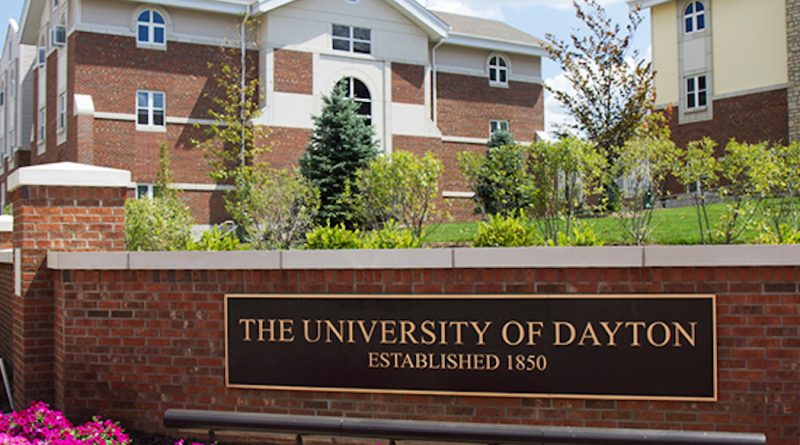OPINION: Amid growing pandemic, UD risks lives
Photo of University of Dayton.

Grace Gibson | Opinion Editor
In the middle of the 2020 Spring Semester at the University of Dayton, students were unexpectedly and expeditiously sent home amidst the growing COVID-19 pandemic.
Lives were uprooted, businesses shut down, and college campuses left empty for the rest of the semester.
On Tuesday, March 10th, the University of Dayton announced its shift to remote learning for the semester and on that same day, the total number of positive COVID-19 cases in Ohio was a mere 3 people, with the total cases in the United States as a whole totaling 710 according to the John Hopkins Coronavirus Resource Center. Since then, COVID-19 cases have skyrocketed across the country.
Mask mandates have been ignored and stay-at-home orders shrugged off. The COVID-19 pandemic has, in true American fashion, become political. To understand the tension of the decisions that the University of Dayton administration is grappling with, we can look no further than to the actions that Gov. DeWine of Ohio has taken thus far.
Because of Trump’s refusal to enact a nationwide lockdown, those decisions have been left to the governors of each state. Gov. Mike DeWine was one of the first governors to take immediate action when he issued a stay-at-home order for all of Ohio on March 22nd, 2020. H
owever, this order did not go without backlash. Dr. Amy Acton, the former Director of the Ohio Department of Health was the leading health coronavirus expert in the state, often advising Gov. DeWine on the necessary action needed to contain the virus. But on June 11th, 2020, Dr. Acton resigned from her position amidst several lawsuits and protests against her actions that led to Ohio’s lockdown.
Since Dr. Acton’s resignation, it seemed to me that there’d been a noticeable lack of appropriate and effective action. However, in the last few weeks, Gov. DeWine has taken a major step in the right direction by enacting a statewide mask order on July 22nd. Unfortunately, this necessary step has also been met with resistance like all of the other initiatives that are necessary to protect the most human lives.
Ohio is not the only state to have such vitriol spouted at government officials. On April 15th, 2020, protestors gathered at the Michigan State Capitol in response to Gov. Gretchen Whitmer’s proclamation of a stay-at-home order. Many of these demonstrators wielded weapons of war under the guise of demonstrating their right to protest.
It was clear that, to me, these demonstrations were nothing more than sheer intimidation. Among those in attendance were White supremacists brandishing Confederate flags, nooses, and signs that read, “Tyrant’s Get The Rope.”
However, amidst the shootings of people of color for simply walking down the street, none of that same action was taken against this majority White, armed crowd.
Compare these images to the militarized response that peaceful protestors have been met with all across the country in the fight against police brutality. We’ve seen play out before us two very different Americas: one in which there are those fighting for the right to live, and those fighting to let others die.
COVID-19 cases continue to surge across all states in America. Ohio has experienced massive surges in recent weeks. According to the Johns Hopkins Coronavirus Resource Center, Ohio has had 37,921 new cases throughout the month of July.
These numbers are set to rise exponentially throughout August and the months ahead. But, despite these troubling statistics, Ohio schools across the state are set to open in just a few weeks. These same institutions shifted to remote learning earlier in the year when confirmed cases in the state were only in triple digits.
The University of Dayton was one of these institutions, and like the others, the University plans to resume in-person classes in the next few weeks, with first-year students set to move in by the time this publication is out. This begs the question; why are these institutions opening up amidst greater threat than they were when they began remote instruction?
With the University of Dayton’s impending return of in-person classes, many important and uncomfortable conversations are bubbling to the surface.
While the University has assured students that we’ll be safe and secure when we return, those assurances are not guaranteed. In fact, they are likely to falter. In a school that is infamously known for its house parties and ceremonious St. Patrick’s Day celebrations, it is irrational to believe that every one of these students will follow the strictures set forth by the University’s Path Forward Return to Campus guidelines.
There is simply no safe way to bring such a large number of students into a condensed campus. When one student breaks the mask mandate, or decides to go to a party, they have the potential to infect thousands on UD’s campus. They put not only student’s lives at risk, but they also put the lives of faculty and staff on the line.
While of course the lives of student’s are important and must be protected, the conversation often fails to include the staff and faculty who keep the University running.
Out of this gap in the conversation has arisen a new organization on UD’s campus: UD Solidarity. This group is led by and advocates for the staff and faculty on UD’s campus who are all too often left as an afterthought to the conversation concerning safety on campus. In a petition that has circulated online to those within and outside of the Dayton community, UD Solidarity calls upon the University to address concerns that staff and faculty have with the plans that the institution has in place thus far. These concerns range from providing additional two-week paid sick leave in the event that staff and faculty fall ill with the virus, to concerns regarding the inclusion of staff and faculty voices in the broader decision making process of the institution.
While I have been outspoken in my support of the efforts of UD Solidarity, I find it necessary to establish that I do not speak for this organization. The opinions expressed in this article are my own. UD Solidarity has acknowledged the difficulty of the situation, and does not call for a complete return to remote learning. That being said, UD Solidarity is seeking student voices to help get their messages across. Students have an obligation to advocate for the lives of those who instruct us. To shirk them off as an afterthought would be to actively place their lives below ours. Staff and faculty are not sacrificial pieces in the financial game of chess.
This problem spans far beyond the University of Dayton’s campus. This is something that all schools are having to deal with. There is this struggle between keeping lives safe and maintaining the financial viability of these institutions.
Frankly, I see only one clear option. Financial viability has no meaning when those who keep these institutions running are sick or dead.
This conversation should not be about seeking less risky alternatives to in-person learning, it should be about not risking anyone’s life at all. The only way to do that is to keep these institutions, including the University of Dayton, remote until it is safe to bring everyone back without the fear that one sneeze or cough is going to kill our roommate or professor.
This differs from the position of UD Solidarity in that the group is not calling for a full return to remote learning in the Fall, rather; staff should have the option to teach their classes remotely and those requests should be granted.
However, I believe that returning to campus knowing that we could all be sent away as quickly as we were last Spring will do nothing but foster fear and unease throughout the UD community. Students should not have to grapple with whether or not to go to class because they’re afraid they will get someone sick. Staff and faculty should not have to wake up every morning and wonder if today is the day that they contract COVID-19 and bring it home to their families. Staff and faculty should not have to work to live and work to die. These fears won’t be productive for anyone. Students and staff will be so focused on making sure they’re not getting anyone sick to fully engage with each other and focus on academics.
These claims that I’m making may sound morbid and intense, but that is the reality that we find ourselves in. Perhaps it’s the human rights studies major in me, but I believe that nobody’s life should be sacrificed for financial integrity or viability.
Protection of human life is of utmost importance in the midst of a pandemic and without. There is no question for me.
Any plan that actively puts staff and students lives on the line for some false sense of normalcy is no plan at all. The only way that everyone on UD’s campus can remain safe is to continue what we accomplished in the Spring.
Remote learning should be a top priority.
Any environment with a condensed number of people, masks or not, is unsafe. If this is too much to ask, at the very least it should be up to the staff and students on which mode of instruction they’d like to pursue. Forcing either to learn or instruct in a way that makes them uncomfortable is unfair and unjust.
Protecting human life on all fronts, staff or students, should be imperative. In my view, the only way to do so surely is to continue remote learning for the Fall semester. Putting lives at risk under the guise of normalcy and safety is not very becoming of a university that prides itself on being “the University for the Common Good.”

